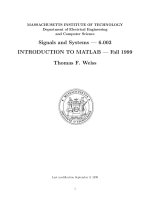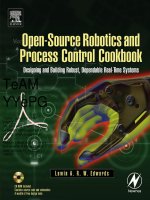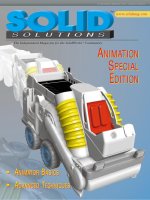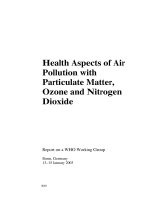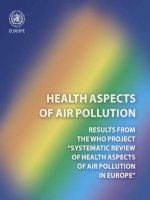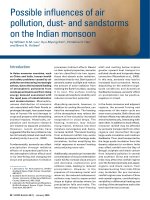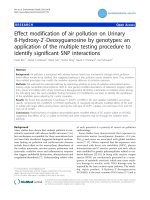Tài liệu Spe Special Feature : Air Pollution Control Technologies ppt
Bạn đang xem bản rút gọn của tài liệu. Xem và tải ngay bản đầy đủ của tài liệu tại đây (345.36 KB, 5 trang )
TECH MONITOR z Nov-Dec 2008 33
Special Feature : Air Pollution Control Technologies
Compressed air car
S.S. Thipse
It is hard to believe that compressed air can be used to drive vehicles. However that
is true, and the “air car”, as it is popularly known, has caught the attention of re-
searchers worldwide. It has zero emissions and is ideal for city driving conditions.
MDI is one company that holds the international patents for the compressed air car.
Although it seems to be an environmentally-friendly solution, one must consider its
well to wheel efficiency. The electricity requirement for compressing air has to be
considered while computing overall efficiency. Nevertheless, the compressed air
vehicle will contribute to reducing urban air pollution in the long run.
Dr. S.S. Thipse
Assistant Director
Engine Development Laboratory
Automotive Research
Association of India (ARAI)
P. O. Box No. 832
Pune 411044, India
Tel: (+91-20) 3023 1434
E-mail:
The history of compressed
air vehicles
ne cannot accurately claim that
compressed air as an energy
and locomotion vector is recent
technology. At the end of the 19th cen-
tury, the first approximations to what
could one day become a compressed
air driven vehicle already existed, with
the arrival of the first pneumatic loco-
motives. In fact, two centuries before
that Dennis Papin apparently came up
with the idea of using compressed air
(Royal Society London, 1687). In 1872
the Mekarski air engine was used for
street transit, consisting of a single-
stage engine. It represented an ex-
tremely important advance in terms of
pneumatic engines, due to its forward
thinking use of thermodynamics, which
ensured that the air was heated, by
passing it through tanks of boiling wa-
ter, which also increased its range be-
tween fill-ups. Numerous locomotives
were manufactured and a number of
regular lines were opened up (the first
O
in Nantes in 1879). In 1892, Robert
Hardie introduced a new method of
heating that at the same time served to
increase the range of the engine.
However, the first urban transport
locomotive was not introduced until
1898, by Hoadley and Knight, and was
based on the principle that the longer
the air is kept in the engine the more
heat it absorbs and the greater its
range. As a result they introduced a
two-stage engine. Figure 1 shows the
early compressed air vehicles.
Charles B. Hodges will always be
remembered as the true father of the
compressed air concept applied to cars,
being the first person, not only to in-
vent a car driven by a compressed air
engine but also to have considerable
commercial success with it. The H.K.
Porter Company of Pittsburgh sold hun-
dreds of these vehicles to the mining
industry in the eastern United States,
due to the safety that this method of
propulsion represented for the mining
sector. Later on, in 1912, the American’s
Special Feature : Air Pollution Control Technologies
34TECH MONITOR z Nov-Dec 2008
Special Feature : Air Pollution Control Technologies
Design of the compressed
air vehicle
Compressed air engine
This engine was developed between
the end of 2001 and the beginning of
2002. It uses an innovative system to
control the movement of the 2nd gen-
eration pistons and one single crank-
shaft. The pistons work in two stages -
one motor stage and one intermediate
stage of compression/expansion. The
engine has 4 two-stage pistons, i.e. 8
compression and/or expansion cham-
bers. They have two functions: to com-
press ambient air and refill the storage
tanks; and to make successive expan-
sions (reheating air with ambient ther-
mal energy) thereby approaching iso-
thermal expansion. Figure 3 shows the
compressed air engine.
Two technologies have been de-
veloped to meet different needs:
z Single energy compressed air en-
gines; and
z Dual energy compressed air plus
fuel engines.
The single energy engines will be
available in both Minicats and Citycats.
These engines have been conceived
for city use, where the maximum speed
is 50 km/h and where MDI believes
polluting will soon be prohibited. The
dual energy engine, on the other hand,
has been conceived as much for the
city as the open road and will be avail-
able in all MDI vehicles. The engines
will work exclusively with compressed
air while it is running under 50 km/h in
urban areas. But when the car is used
outside urban areas at speeds over 50
km/h, the engines will switch to fuel
mode. The engine will be able to use
gasoline, gas oil, bio-diesel, gas, liq-
method was improved by Europeans,
adding a further expansion stage to the
engine - 3 stages.
Compressed air technology
After twelve years of research and de-
velopment, Guy Negre has developed
an engine that could become one of
the biggest technological advances of
this century. A French engineer by pro-
fession, he has designed a low con-
sumption and low pollution engine for
urban motoring that runs on compressed
air technology (Figure 2). The CATS
(Compressed Air Technology System)
“air car” from Motor Development In-
ternational is a significant step for zero-
emission transport, delivering a com-
pressed air-driven vehicle that is safe,
quiet, has a top speed of 110 km/h and
a range of 200 km. Costing next to noth-
ing to run, the Zero Emission Vehicle
(ZEV) range - which includes a pick-up
truck and van - was released in 2005.
Guy Nègre is the head of Research and
Development at Moteur Developement
International (MDI) cars, where the Zero
Emission Vehicle (ZEV) prototype has
been in production since 1994. The two-
stroke engine is powered by com-
pressed air stored in tanks at about 150
times the pressure in car tyres. The ex-
pansion of the compressed air drives
the pistons to create movement, replac-
ing the burning of fossil fuel in a con-
ventional engine. In an air-refilling sta-
tion (currently unavailable as service
stations have not been fitted yet) it is
estimated to take between three and
four minutes to re-fuel. At home, with a
220V plug, it takes three and a half
hours.
CAT vehicles have significant eco-
nomical and environmental advan-
tages. With the incorporation of bi-en-
ergy (compressed air + fuel) the CAT
Vehicles have increased their driving
range to close to 2000 km with zero
pollution in cities and considerably re-
duced pollution outside urban areas.
Also, the application of the MDI engine
in other areas, outside the automotive
sector, opens a multitude of possibili-
ties in nautical fields, co-generation,
auxiliary engines, electric generators
groups, etc.
Compressed air is a new viable
form of power that allows the accumu-
lation and transport of energy. MDI is
very close to initiating the production
of a series of engines and vehicles. The
company is financed by the sale of
manufacturing licenses and patents all
over the world. Table 1 lists the techni-
cal specifications of the vehicle.
Figure 1: Some early compressed air vehicles
Figure 2: MDI vehicles
TECH MONITOR z Nov-Dec 2008 35
Special Feature : Air Pollution Control Technologies
uidized gas, ecological fuel, alcohol,
etc. Both engines will be available with
2, 4 and 6 cylinders, When the air tanks
are empty the driver will be able to
switch
to fuel mode, thanks to the car’s
on board computer.
Engine working
Approximately 90m
3
of compressed air
is stored in fibre tanks in the vehicle.
The engine is powered by compressed
air, stored in a carbon-fibre tank at 30
MPa (4500 psi). The tank is made of
carbon fibre in order to reduce its
weight. The engine has injection simi-
lar to normal engines, but uses special
crankshafts and pistons, which remain
at top dead centre for about 70 degrees
of the crankshaft’s cycle; this allows
more power to be developed in the
engine. The expansion of this air
pushes the pistons and creates move-
ment. The atmospheric temperature is
used to re-heat the engine and increase
the road coverage. The air condition-
ing system makes use of the expelled
cold air. Due to the absence of com-
bustion and the fact there is no pollu-
tion, the oil change is only necessary
every 50,000 km.
Distribution and valves
To ensure smooth running and to opti-
mize energy efficiency, air engines use
a simple electromagnetic distribution
system, which controls the flow of air
into the engine. This system runs on
very little energy and alters neither the
valve phase nor its rise.
No clutch is necessary. The en-
gine is idle when the car is stationary
and the vehicle is started by the mag-
netic plate, which re-engages the com-
pressed air. Parking manoeuvers are
powered by the electric motor. The P04
engine is equipped with patented vari-
able-volume butts and a dynamic vari-
able-volume volumetric reducer. The
engines can be equipped with and run
on dual energies - fossil fuels and com-
pressed air - and incorporate a reheat-
ing mechanism between the storage
tank and the engine.
This mechanism allows the engine
to run exclusively on fossil fuel, which
permits compatible autonomy on the
road. While the car is running on fossil
fuel, the compressor refills the com-
pressed air tanks. The control system
maintains a zero-pollution emission in
the city at speeds up to 60 km/h.
Articulated con-rod
The MDI con-rod system allows the pis-
ton to be held at Top Dead Centre for
70
o
of the cycle.This way, enough time
is given to create the pressure in the
cylinder. The torque is also better, so
the force exerted on the crankshaft is
less substantial. Figure 4 shows the ar-
ticulated connecting rod and the drive
train.
Gear box
Gear changes are automatic, powered
by an electronic system developed by
MDI. A computer which controls the
speed of the car is effectively continu-
ously changing gears. The latest of
many previous versions, this gearbox
achieves the objective of seamless
changes and mimimal energy con-
sumption. Its steering wheel is equipped
with a 5kW electric moto-alternator. This
moto-alternator connects the engine to
the gearbox. It has many functions:
z It supports the CAT’s motor to allow
the tanks to be refilled.
Figure 3: Compressed air engine
Table 1: Technical specifications of a Minicat vehicle
Mono-energy Dual-energy 2 Dual-energy 4
Length m 2.65 2.65 2.65
Width m 1.62 1.62 1.62
Height m 1.66 1.66 1.66
Number of seats - 3 3 3
Luggage compartment
volume Dm
3
500/700 500/700 500/700
Weight Kg 550 520 540
Engine - 41P03 41P01 41P01/4
Power c v 25 25 50
Max. speed Km/h 110 125 140
Urban range (zero pollution) Km 140/150 50 50
CO
2
emission in urban use g/Km 0 0 0
Non-urban range Km 80 1650 1500
Non-urban consumption
(petrol) litres - 1.8 2
CO
2
emission in
non-urban use g/Km 0 35 40
Price (from) taxes included € 9200
36TECH MONITOR z Nov-Dec 2008
Special Feature : Air Pollution Control Technologies
z It starts the vehicle and provides
extra power when necessary.
z As an alternator it produces brake
power.
Additional features
of the MDI car
z Light-weight: The vehicle has a fi-
berglass body, which makes it a
light, silent urban car. The car’s body
is tubular, and is held together us-
ing aerospace technology. It can
reach speeds up to 220 km/h (even
though the legal limit is 120).
z It does not have normal speed
gauges. Instead, it has a small com-
puter screen that shows the speed.
z Its electric system is also revolution-
ary. MDI has bought a patent that is
bound to reduce the importance of
electrical systems in all cars. The
trick consists in using a small radio
signal. The system makes the car
20 kilograms lighter and consider-
ably quieter.
z In the single energy mode, MDI cars
consume less than one euro every
100 km (around 0.75 euros), that is
to say, 10 times less than gasoline-
powered cars.
z Its driving range is close to twice
that of the most advanced electric
cars (from 200 to 300 km or 8 hours
of circulation). This is exactly what
the urban market needs where, 80
per cent of the drivers move less
than 60 km a day.
z The recharging of the car will be
done at gas stations, once the mar-
ket is developed. To fill the tanks, it
will take about 2 to 3 minutes at a
price of 1.5 euros. After refilling, the
car will be ready to drive 200 kilo-
meters. The car also has a small
compressor that can be connected
to an electrical network (220V or
380V) and will recharge the tanks
completely in 3 or 4 minutes.
z Because the engine does not burn
any fuel, the car’s oil only needs to
be changed every 50,000 km.
z The temperature of the clean air
expelled from the exhaust pipe is
between 0 and -15 degrees and
can be subsequently channelled
and used for air conditioning in the
interior of the car.
z Advanced features such as GSM
telephone systems, GPS satellite
tracking systems, programmes for
delivery people, emergency sys-
tems, Internet connections, voice
recognitions, map presentation and
traffic information can be incorpo-
rated.
z Regarding security, the seatbelt
system is different from what is
known. One part of the belt is an-
chored to the floor of the car, like
traditional cars. The other part of the
belt, instead of being attached to
the side of the car, is also anchored
to the floor of the vehicle. This helps
to secure the bodies of the driver
and passengers in the case of a
collision.
z There are no keys - just an access
card that can be read by the car
from your pocket.
Safety features of the air car
The CATS air tanks store 90m
3
of air at
300 bars of pressure (four tanks have
a capacity of 90 litres, and they store
90m
3
of air at a pressure of 300 bars),
just like tanks already used to carry liq-
uefied gases on some urban buses.
That means that the tanks are prepared
and certified to carry an explosive prod-
uct: methane gas. In the case of an ac-
cident with air tank breakage, there
would be no explosion or shattering
because the tanks are not metallic but
made of glass fibre. The tanks would
crack longitudinally, and the air would
escape, causing a strong buzzing sound
with no dangerous factor. It is clear that
if this technology has been tested and
prepared to carry an inflammable and
explosive gas, it can also be used to
carry air.
In order to avoid the so-called ‘rocket
effect’ (air escaping through one of the
tank’s extremities causing a pressure leak
that could move the car), MDI made a
small but important change in the design.
Where the valve on the bus tanks are
placed on one of the extremities, MDI has
placed the valve in the middle of the tank
reducing the ‘rocket effect’ to a minimum
(Figure 5).
Air car in India
Tata Motors has signed an agreement
with Moteur Development International
of France to develop a car that runs on
compressed air, thus making it very
economical to run and almost totally
pollution free. Although there is no offi-
cial word on when the car will be com-
mercially manufactured for India, re-
ports say that it will be sooner than later.
The car - MiniCAT - could cost around
Rs 350,000 in India and would have a
range of around 300 km between refu-
els. The cost of a refill would be about
Rs 90. In the single energy mode MDI
cars consume around Rs 45 every 100
km. Figure 6 shows the proposed air
car for India. The smallest and most in-
novative (three seats, minimal dimen-
sions with the boot of a saloon), it is a
great challenge for such a small car
which runs on compressed air. The
MiniCAT is the city car of the future.
Other developments in com-
pressed air car technology
Currently some new technologies re-
garding compressed air cars have
emerged. A Republic of Korean com-
pany has created a pneumatic hybrid
electric vehicle car engine that runs on
Figure 4: Articulated connecting rod and drive train
TECH MONITOR z Nov-Dec 2008 37
Special Feature : Air Pollution Control Technologies
electricity and compressed air. The en-
gine, which powers a pneumatic-hy-
brid electric vehicle (PHEV), works
alongside an electric motor to create
the power source. The system elimi-
nates the need for fuel, making the
PHEV pollution-free. The system is con-
trolled by an ECU in the car, which con-
trols both power packs i.e. the com-
pressed-air engine and electric motor.
The compressed air drives the pistons,
which turn the vehicle’s wheels. The air
is compressed, using a small motor,
powered by a 48-volt battery, which
powers both the air compressor and
the electric motor. Once compressed,
the air is stored in a tank. The com-
pressed air is used when the car needs
a lot of energy, such as for starting up
and acceleration. The electric motor
comes to life once the car has gained
normal cruising speed. The PHEV sys-
tem could reduce the cost of vehicle
production by about 20 per cent, be-
cause there is no need for a cooling
system, fuel tank, spark plugs or silenc-
ers. Figure 7 shows the PHEV in the
Republic of Korea.
Well to wheel efficiency of a
compressed air car
We are all familiar with the standard
measure of vehicle efficiency. Miles per
gallon, or the CO
2
emissions derived
from it does not show the whole pic-
ture. The drilling, pumping, transport-
ing, and refining of petroleum products
such as gasoline and diesel requires
additional energy that we often over-
look. By some estimates this “well to
tank” phase adds 15-20 per cent to the
emissions/energy use.
But where does the energy go
once it gets into the vehicle’s tank. First,
the car must overcome the aerody-
namic drag in order to maintain a given
velocity. For this, figures for the vehicle’s
coefficient of drag, the cross sectional
area and the density of air are required.
Multiplying the coefficient of drag by
the cross sectional area results in a
good indicator of how aerodynamic a
car is. In case of the compressed air
car, the electrical energy that is required
to compress the air lowers the overall
efficiency. Furthermore, environmental
pollution generated at the electricity
source should also be considered. To
be precise, the efficiency from com-
pressor to wheel of the air car is calcu-
lated to be ~40 per cent according to
some reports. In comparison, the effi-
ciency of electric vehicles from battery
to wheel is 80 per cent. If the air com-
pressor is powered by an ICE with an
efficiency of about 40 per cent, then the
overall efficiency of the air car from fuel
to wheel is 40% x 40% = 16%, which is
poor, as compared to an IC engine or
battery-electric powertrain.
Conclusion
The technology of compressed air ve-
hicles is not new. In fact, it has been
around for years. Compressed air tech-
nology allows for engines that are both
non-polluting and economical. After ten
years of research and development, the
compressed air vehicle will be intro-
duced worldwide. Unlike electric or
hydrogen powered vehicles, com-
pressed air vehicles are not expensive
and do not have a limited driving range.
Compressed air vehicles are afford-
able and have a performance rate that
stands up to current standards. To sum
it up, they are non-expensive cars that
do not pollute and are easy to get
around in cities. The emission benefits
of introducing this zero emission tech-
nology are obvious. At the same time
the well to wheels efficiency of these
vehicles need to be improved.
References
1. SAE 1999-01-0623, Schechter.M.,
“New Cycles for Automobile en-
gines.”
2. Internet website, www.theaircar. com.
3. Internet website, www.peswiki.com
4. Internet website, www.mdi.lu Internet
website />2007/06/01/tata-motors-air-car.
Figure 5: Position of air tanks in a compressed air vehicle
Figure 6: Compressed air car for
India
Figure 7: PHEV in Republic of Korea
Reserva
de Aire
Interca-
mbiadores
de calor
Escape
Pistones
Depositos
Placa de protection
